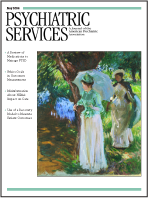One-Year Housing Arrangements Among Homeless Adults With Serious Mental Illness in the ACCESS Program
Abstract
OBJECTIVE: This study examined the various living arrangements among formerly homeless adults with mental illness 12 months after they entered case management. METHODS: The study surveyed 5,325 clients who received intensive case management services in the Access to Community Care and Effective Services and Supports (ACCESS) program. Living arrangements 12 months after program entry were classified into six types on the basis of residential setting, the presence of others in the home, and stability (living in the same place for 60 days). Differences in perceived housing quality, unmet housing needs, and overall satisfaction were compared across living arrangements by using analysis of covariance. RESULTS: One year after entering case management, 37 percent of clients had been independently housed during the previous 60 days (29 percent lived alone in their own place and 8 percent lived with others in their own place), 52 percent had been dependently housed during the previous 60 days (11 percent lived in someone else's place, 10 percent lived in an institution, and 31 percent lived in multiple places), and 11 percent had literally been homeless during the previous 60 days. Clients with less severe mental health and addiction problems at baseline and those in communities that had higher social capital and more affordable housing were more likely to become independently housed, to show greater clinical improvement, and to have greater access to housing services. After the analysis adjusted for potentially confounding factors, independently housed clients were more satisfied with life overall. However, no significant association was found between specific living arrangements and either perceived housing quality or perceived unmet needs for housing. CONCLUSIONS: Living independently was positively associated with satisfaction of life overall, but it was not associated with the perception that the quality of housing was better or that there was less of a need for permanent housing.



